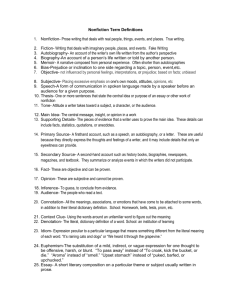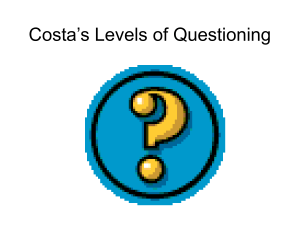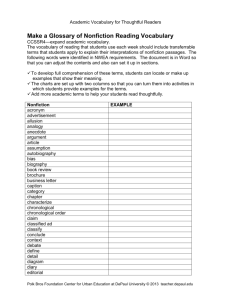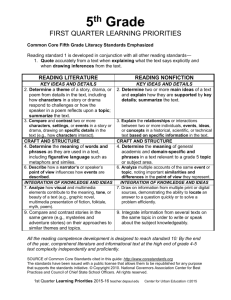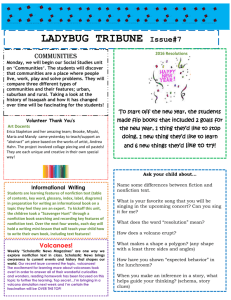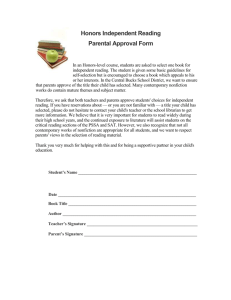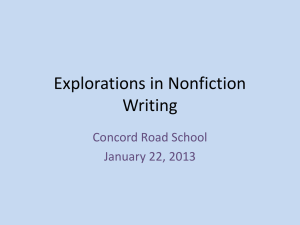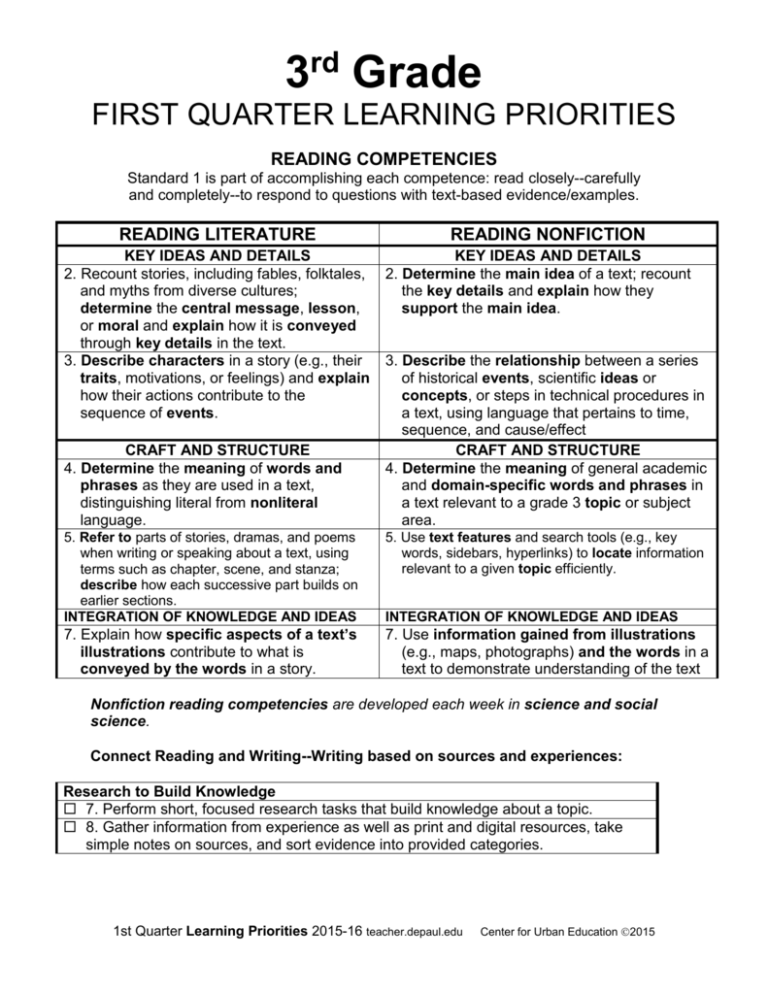
3rd Grade
FIRST QUARTER LEARNING PRIORITIES
READING COMPETENCIES
Standard 1 is part of accomplishing each competence: read closely--carefully
and completely--to respond to questions with text-based evidence/examples.
READING LITERATURE
KEY IDEAS AND DETAILS
2. Recount stories, including fables, folktales,
and myths from diverse cultures;
determine the central message, lesson,
or moral and explain how it is conveyed
through key details in the text.
3. Describe characters in a story (e.g., their
traits, motivations, or feelings) and explain
how their actions contribute to the
sequence of events.
CRAFT AND STRUCTURE
4. Determine the meaning of words and
phrases as they are used in a text,
distinguishing literal from nonliteral
language.
READING NONFICTION
KEY IDEAS AND DETAILS
2. Determine the main idea of a text; recount
the key details and explain how they
support the main idea.
3. Describe the relationship between a series
of historical events, scientific ideas or
concepts, or steps in technical procedures in
a text, using language that pertains to time,
sequence, and cause/effect
CRAFT AND STRUCTURE
4. Determine the meaning of general academic
and domain-specific words and phrases in
a text relevant to a grade 3 topic or subject
area.
5. Refer to parts of stories, dramas, and poems
when writing or speaking about a text, using
terms such as chapter, scene, and stanza;
describe how each successive part builds on
earlier sections.
INTEGRATION OF KNOWLEDGE AND IDEAS
5. Use text features and search tools (e.g., key
words, sidebars, hyperlinks) to locate information
relevant to a given topic efficiently.
7. Explain how specific aspects of a text’s
illustrations contribute to what is
conveyed by the words in a story.
7. Use information gained from illustrations
(e.g., maps, photographs) and the words in a
text to demonstrate understanding of the text
INTEGRATION OF KNOWLEDGE AND IDEAS
Nonfiction reading competencies are developed each week in science and social
science.
Connect Reading and Writing--Writing based on sources and experiences:
Research to Build Knowledge
7. Perform short, focused research tasks that build knowledge about a topic.
8. Gather information from experience as well as print and digital resources, take
simple notes on sources, and sort evidence into provided categories.
1st Quarter Learning Priorities 2015-16 teacher.depaul.edu
Center for Urban Education 2015
All the reading competence development is designed to reach standard 10:
By the end of the year, read and
comprehend literature, including stories,
dramas, and poetry, at the high end of the
grades 2–3 text complexity band
independently and proficiently.
By the end of the year, read and comprehend
informational texts, including history/social
studies, science, and technical texts, at the
high end of the grades 2–3 text complexity band
independently and proficiently.
Read, Write, Make Field Trips,
Connect Literacy to Learning about Chicago—
Readings, Timelines, and Activity Resources for learning about
Chicago are available at http://teacher.depaul.edu .
1st Quarter Learning Priorities 2015-16 teacher.depaul.edu Center for Urban Education 2015
2
The Speaking and Listening Standards are Keys to Learning
ACROSS the Curriculum
Comprehension and Collaboration
SL.3.1 Engage effectively in a range of collaborative discussions (one-on-one, in
groups, and teacher-led) with diverse partners on grade 3 topics and texts, building
on others’ ideas and expressing their own clearly.
__SL.3.1a Come to discussions prepared, having read or studied required material;
explicitly draw on that preparation and other information known about the topic
to explore ideas under discussion.
__SL.3.1b Follow agreed-upon rules for discussions (e.g., gaining the floor in
respectful ways, listening to others with care, speaking one at a time about the
topics and texts under discussion).
__SL.3.1c Ask questions to check understanding of information presented, stay on
topic, and link their comments to the remarks of others.
__SL.3.1d Explain their own ideas and understanding in light of the discussion.
SL.3.2 Determine the main ideas and supporting details of a text read aloud or
information presented in diverse media and formats, including visually,
quantitatively, and orally.
SL.3.3 Ask and answer questions about information from a speaker, offering
appropriate elaboration and detail.
Presentation of Knowledge and Ideas
SL.3.4 Report on a topic or text, tell a story, or recount an experience with
appropriate facts and relevant, descriptive details, speaking clearly at an
understandable pace.
SL.3.5 Create engaging audio recordings of stories or poems that demonstrate fluid
reading at an understandable pace; add visual displays when appropriate to
emphasize or enhance certain facts or details.
SL.3.6 Speak in complete sentences when appropriate to task and situation in order
to provide requested detail or clarification.
Students exercise Speaking and Listening competencies as they proceed through
the gradual release of responsibility.
1st Quarter Learning Priorities 2015-16 teacher.depaul.edu Center for Urban Education 2015
3
Writing Competencies
Note: The emphasis of writing is on the PCR—the prose constructed response
PCR Prose Constructed Response
A task that requires students to write a response to a question that may focus on one
reading or may require students to analyze two readings or two readings and a video. If
the task requires students to respond to two texts or to two texts and a video the student
first completes responses to questions about each reading or video.
“The Narrative Task broadens the way in which students may use this type of writing.
Narrative writing can be used to convey experiences or events, real or imaginary. In
this task, students may be asked to write a story, detail a scientific process, write a
historical account of important figures, or to describe an account of events, scenes or
objects, for example.” (Source: PARCConline.org)
The following two PCRs from PARCC samples are responses to stories.
PCR based on one story.
This story tells about Derrick’s first camping trip. Write Derrick’s journal entry
about this camping trip. Include information about how the characters responded
to the events in the story as you write the journal.
This PCR asks students to add to a narrative. Students can do similar tasks to increase
understanding of a story—
Write a letter from a character reporting on the main event
Write a journal of one of the characters
Write an additional part of the story—the sequel.
PCR based on two stories.
Old Mother West Wind and the Sandwitch both try to teach important lessons to
characters in the stories. Write an essay that explains how Old Mother West
Wind’s and the Sandwitch’s words and actions are important to the plots of the
stories. Use what you learned about the characters to support your essay.
This PCR is a Literature Task in which students compose an analytic essay.
During first quarter, students should complete analyses of individual stories so that they
develop competence to write such an essay.
SOURCE of Common Core Standards cited in this guide: http://www.corestandards.org
The standards have been issued with a public license that allows them to be republished for any purpose
that supports the standards initiative. © Copyright 2010. National Governors Association Center for Best
Practices and Council of Chief State School Officers. All rights reserved.
1st Quarter Learning Priorities 2015-16 teacher.depaul.edu Center for Urban Education 2015
4
MATH MIX: New and Continuing PRIORITIES
Research confirms that if the math curriculum includes “frequent cumulative review” that enables students
to retain greater math competence. Among sources supporting this “mix” is the report “Assisting Students
Struggling with Mathematics” of the What Works Clearinghouse, IES Practice Guide, US Department of
Education. This chart is included to organize planning for new math content and inclusion of math
learned earlier in the school year in activities such as: learning centers; “bell ringers”; homework, art,
science, social science--Integrating math into science and social science makes math more meaningful.
Math Practice Standards should be emphasized
—particularly standard 1: Make sense of problems and persevere in solving them.
Week of
New Math
Math “Mix”—Content to Revisit
Homework Essential: Students need to take home an example of how to solve
problems—that teachers prepare or that they prepare so they can practice correctly.
Daily kinds of assessment:
__glossary __journal __my own example __change the problem, solve it
__ _______________ __ _________________________________
Weekly kinds of assessment:
__solve problem, explain patterns and strategies __write math booklet
__make my own “anchor chart” __make “math path”—steps to solution
__ __________________________ __ ________________
1st Quarter Learning Priorities 2015-16 teacher.depaul.edu Center for Urban Education 2015
5
Third Grade: First Quarter, Weeks 1-2 Learning Priorities
Literature and nonfiction literacy vocabulary listed for each two-week sequence should be incorporated in demonstrations and
guided reading and student responses. Writing is integrated into responses and tasks based on literature and nonfiction.
Literature Genre
Reading
Literature
CCSSRL3:3 analyze
characters
Week of September 7
__fairy tale __folk tale
__realistic fiction __fable
__ ______________________
Week of September 14
__fairy tale __folk tale
__realistic fiction __fable
__ ______________________
How
does
a writer tell you a character’s
Take reading interest survey.
traits?
What do you like about reading
RELATE CHARACTER TRAITS AND
stories?
RELATE CHARACTER ACTIONS TO ACTIONS and MOTIVES
TRAITS (relates to organizing a
Describe and analyze character,
motives, plot
Infer the meaning of collaborative classroom)
character traits
a word in context
CCSSR4—ongoing— Draw characters, showing traits. Who Does What
include weekly.
LITERARY TERMS:
CHARACTER,
ACTION, TRAIT;
CONTEXT;
EVIDENCE
Nonfiction
Sources
Science
CCSSRI.3.2
Identify important
information
Social Science
CCSSRI.3.2
Classify and
evaluate information
Writing
Conventions
Word Patterns
and Grammar
CCSSR.3.4
Classify vocabulary
Why
Character Trait_Evidence_
Integrate Writing/Speaking/Art:
INTEGRATE WRITING/SPEAKING/ART:
Descriptive sentences. Describe JOURNAL—start the reader’s journal,
telling in words and pictures what you
a character, person, or place so
clearly another student can identify liked and learned about literature this
week.
__topic book __video __museum
exhibit __dictionary __map
__online reference tool
______________
Science Interest Survey:
What do you like about
science?
What is your favorite science
topic?
Write and draw to explain it.
Take knowledge and interest
survey:
What do you like about the city
of Chicago?
Places
People
Transportation
Natural environment
Write sentences about the part
you like most.
Assess writing abilities: Write
sentences to narrate an
action—including sequence
words.
Assess student phonics needs.
__topic book __video __museum exhibit
__dictionary __map
__online reference tool ______________
How do people learn science?
Learn about a topic by reading,
observing, then.
List what you think the most important
facts are that you see in the pictures or
diagrams.
Make glossary of words you think are
important.
Read/think--How has Chicago changed?
List changes.
Then illustrate one you think is most
important.
Online Links to…
Chicago Readings
Chicago Timeline
Assess writing abilities: outline and then
write a paragraph about any topic you’re
interested in.
Assess grammar knowledge: Identify
parts of speech in sentences—
Underline nouns, circle verbs.
1st Quarter Learning Priorities 2015-16 teacher.depaul.edu Center for Urban Education 2015
6
Third Grade: First Quarter, Weeks 3-4 Learning Priorities
Literature and nonfiction literacy vocabulary listed for each two-week sequence should be incorporated in demonstrations and
guided reading and student responses. Writing is integrated into responses and tasks based on literature and nonfiction.
Literature
Genre
Reading
Literature
CCSSRL.3.3
Analyze plot—
problem and
solution
LITERACY
TERMS:
PLOT;
PROBLEM;
SOLUTION;
SUMMARY;
LESSON;
sequence
Nonfiction
Sources
Week of September 21
__fairy tale __folk tale
__realistic fiction __fable
__ ______________________
Analyze plot of a story
Analyze plot of a story
Identify words the writer uses to Increase complexity of text as
help explain the sequence of
events.
Identify information about
problem and solution in a
story.
Then write summary of the plot.
Integrate Writing/Speaking/Art:
CONSTRUCTED RESPONSE-How does the writer use the plot
to tell you a message or teach a
lesson? (theme) How does the
illustrator help? Pair and
Compare responses.
__topic book __video __museum
exhibit __dictionary __map
__online reference tool ___________
Science
Describe the structure of the
or
text—how it is organized
Social Science
List: Main Idea of each
CCSSRI.3.2
Locate important
information using
structure of the
text.
LITERACY TERMS:
PARAGRAPH; MAIN
IDEA; SUPPORTING
INFORMATION;
SUMMARY;
STRUTURE OF
TEXT
paragraph in a passage.
For each idea, list one fact that
supports it.
students apply same strategies from
previous week.
Identify words the writer uses to help
explain the sequence of events.
Identify information about problem
and solution in a story.
Then write summary of the plot.
Integrate Writing/Speaking/Art:
CONSTRUCTED RESPONSE--How
does the writer use the plot to tell you
a message or teach a lesson?
(theme) Pair and compare
responses.
__topic book __video __museum exhibit
__dictionary __map
__online reference tool ______________
Describe the structure of the text—
how it is organized
List: Main Idea of each paragraph in a
passage.
For each idea, list one fact that
supports it.
Make glossary.
Make glossary.
Use dictionary
Use dictionary
INTEGRATE WRITING: WRITE A
SUMMARY PARAGRAPH; EXPLAIN
WHAT YOU LEARNED.
Analyze “mentor” paragraph—how
does the writer keep focus and provide
support? Then write your own.
Online resource: Paragraph with
focus, support.
INTEGRATE WRITING: WRITE A
SUMMARY PARAGRAPH; EXPLAIN
WHAT YOU LEARNED.
Analyze “mentor” paragraph—how does the
writer keep focus and provide support?
Then write your own.
Online resource: Paragraph with focus,
support.
Word Patterns Identify
singular and plural nouns.
and Grammar
List five singular nouns
Analyze word
patterns
Week of September 28
__fairy tale __folk tale
__realistic fiction __fable
__ ______________________
from passage.
List three plural nouns.
Classify singular and plural
nouns from this week’s reading.
singular
plural
1st Quarter Learning Priorities 2015-16 teacher.depaul.edu Center for Urban Education 2015
7
Third Grade: First Quarter, Weeks 5-6 Learning Priorities
Literature and nonfiction literacy vocabulary listed for each two-week sequence should be incorporated in demonstrations and
guided reading and student responses. Writing is integrated into responses and tasks based on literature and nonfiction.
Literature
Genre
Reading
Literature
CCSSRL.
Develops 3—
relationships;
and 5—author’s
choices that
communicate
about events and
characters
LITERATURE
TERMS: author;
plot; cause;
effect; analyze;
infer; evidence;
predict
Nonfiction
Sources
Week of October 5
__fairy tale __folk tale
__realistic fiction __fable
__ ______________________
Week of October 12
__fairy tale __folk tale
__realistic fiction __fable
__ ______________________
ANALYZE CAUSES AND EFFECTS
Mid-Quarter Assessment
Analyze and infer causes and
effects.
Infer the traits that the characters’
choices tell about them.
Infer the values that are important
to the characters based on the
kinds of responses they make to
other characters.
Identify ways the writer helps you
understand the characters’ actions
and reasons for them.
Integrate Writing/Speaking/Art:
Write short constructed response to
a story or history. Example: Write
journal of a character or letter from one
character to another character. Cite
examples from the story including
illustrations. Pair, Compare, Repair
(improve).
__topic book __video __museum
exhibit __dictionary __map
__online reference tool ____________
Science
Trace relationships—sequence and
or
cause-effect in science or social
Social Science science situation.
CCSSRI.3.3—
trace relationships
LITERACY
TERMS:
TEXT FEATURES;
RELATIONSHIPS;
CAUSES AND
EFFECCTS;
SEQUENCE;
HEADINGS
Online resource: Analyze and
infer causes and effects.
Make glossary and use dictionary
(ongoing)
INTEGRATE WRITING:
CONSTRUCTED RESPONSE—How
does the writer help you understand
relationships—what words or headings
or other text features does the writer
use to help you understand them?
Word Patterns
and Grammar Identify verb tense
Analyze and use
word patterns
Make chart of verbs from a
passage:
past present future
ANALYZE CAUSES AND EFFECTS,
then predict
Online resources—graphic
organizers you can use to guide or
assess:
Analyze and infer causes and
effects.
Predict with evidence from story—
What will happen? Why?
Integrate Writing/Speaking/Art:
Write short constructed response to a
story. Explain how the writer helps you
understand the plot. Explain how the
illustrations help you see the characters
and setting and focus on important
actions. Pair/compare/repair.
__topic book __video __museum exhibit
__dictionary __map
__online reference tool ______________
Trace relationships—sequence and
cause-effect in science or social
science situation.
Analyze and infer causes and
effects.
Make glossary and use dictionary
(ongoing)
MIDQUARTER ASSESSMENT: How do
you learn when you read nonfiction? What
text features help you learn?
Adjust verb tense.
Choose verbs from passage. Then
make them past-present-future
past present
future
1st Quarter Learning Priorities 2015-16 teacher.depaul.edu Center for Urban Education 2015
8
Third Grade: First Quarter, Weeks 7-8 Learning Priorities
Literature and nonfiction literacy vocabulary listed for each two-week sequence should be incorporated in demonstrations and
guided reading and student responses. Writing is integrated into responses and tasks based on literature and nonfiction.
Literature Genre
Reading Literature
CCSSRL.3.2
Analyze story structure
to determine theme.
And 5—how the writer
communicates it.
LITERACY TERMS:
Theme; main character;
problem and solution;
plot structure
Week of October 19
__fairy tale __folk tale
__realistic fiction __fable
__ ______________________
STORY ELEMENTS
“Map” story: main characters,
their traits and actions, problem
and solution.
INFER THEME/MESSAGE
Analyze how the author
communicates it—citing the parts
of the story, particularly the plot
structure.
INTEGRATE
WRITING/Speaking/Art: dramatize
the story—write a scene.
Nonfiction
Sources
Science
or
Social Science
CCSSRI.3.2
Organize information
to support ideas
CCSSRI3.5—use of
text features
LITERACY TERMS:
essay; outline; response;
evidence
__topic book __video __museum
exhibit __dictionary __map
__online reference tool ______________
Week of October 26
__fairy tale __folk tale
__realistic fiction __fable
__ ______________________
STORY ELEMENTS – continue to
focus on structure of story, increase
complexity of text.
“Map” story: main characters,
their traits and actions, problem
and solution.
INFER THEME/MESSAGE
Analyze how the author
communicates it—citing the parts
of the story, particularly plot
structure.
Integrate Writing/Speaking/Art: act
out the drama you wrote—with
expression.
__topic book __video __museum
exhibit __dictionary __map
__online reference tool
______________
Locate information to answer a BIG
Locate information to answer a BIG
question or support a big idea.
From the passage
From the
illustrations/diagrams/map/….
Identify ways the writer uses text
features to teach you about the topic.
question or support a big idea.
From the passage
From the illustrations/
diagrams/map/…
Identify ways the writer uses text
features to teach you about the topic.
INTEGRATE WRITING: outline a
response to the BIG question. Then
draft it as an essay. In the outline, note
the evidence that you will use to support
each idea.
Make glossary.
INTEGRATE WRITING: WRITE THE
RESPONSE YOU OUTLINED LAST
WEEK.
Make glossary.
Use dictionary
Use dictionary
Word Patterns
and Grammar
Analyze word patterns
Infer from context
Identify root words
Make root word charts
Root
Two Words with Root
Identify and use suffixes.
Make suffix chart:
Suffix:____________
Word
+ Suffix = Meaning
Combine with the root words
charts—make your own word
analysis guides.
1st Quarter Learning Priorities 2015-16 teacher.depaul.edu Center for Urban Education 2015
9
Third Grade: First Quarter, Weeks 9-10 Learning Priorities
Literature and nonfiction literacy vocabulary listed for each two-week sequence should be incorporated in demonstrations and
guided reading and student responses. Writing is integrated into responses and tasks based on literature and nonfiction.
Week of November 2
Literature Genre
Reading Literature
CCSSRL.3.2
Summarize and infer
theme
Literacy Terms:
Mentor text;
narrative; sequel;
journal
Nonfiction Sources
__fairy tale __folk tale
__realistic fiction __fable
__ ______________________
INFER THEME/MESSAGE of a
story.
List ways the writer helps you
learn that theme.
INTEGRATE
WRITING/speaking/art:
Write a narrative based on a
mentor text.
First, outline it and note the
techniques the writer used.
Then either write the sequel-next part of the story or the
journal of a character in the
story.
Add illustrations.
Present it—dramatize it.
Week of November 9 comprehensive
assessment
__fairy tale __folk tale
__realistic fiction __fable
__ ______________________
Comprehensive Assessment
Analyze author’s use of details and
techniques to:
Show character traits
Explain motives
Make the theme or moral clear
INTEGRATE WRITING/speaking/art
Explain with examples how the
author does each of those and how
illustrations help communicate.
__topic book __video __museum
__topic book __video __museum
exhibit __dictionary __map
exhibit __dictionary __map
__online reference tool __________ __online reference tool _____________
Science
or
Social Science
Identify ideas, relate to
supporting details.
Comprehensive Assessment
How do you learn when you read
nonfiction?
Use outline to show the main Show how you start with a
CCSSRI.3.2
topic and main idea and key
question, then locate information,
Support ideas with
evidence
details of each paragraph in
then organize it to respond.
CCSSR7—integrate
a text.
information from different Then identify the CENTRAL
Identify two different ideas about
sources.
idea of the whole passage
a topic from two different
based on your outline.
sources—one can be a video.
Support each idea with
INTEGRATE WRITING:
information from the text.
WRITE A SUMMARY OF THE
PASSAGE.
Word Patterns and
Grammar
Identify and use prefixes
Make prefix chart
Analyze word patterns
Infer from context
PREFIX: ______
Word
Meaning
Comprehensive Assessment
Locate words in reading with
prefixes and suffixes.
Explain how the prefix or suffix
affects meaning.
Complete verb tense chart—past,
present, future
1st Quarter Learning Priorities 2015-16 teacher.depaul.edu Center for Urban Education 2015
10

